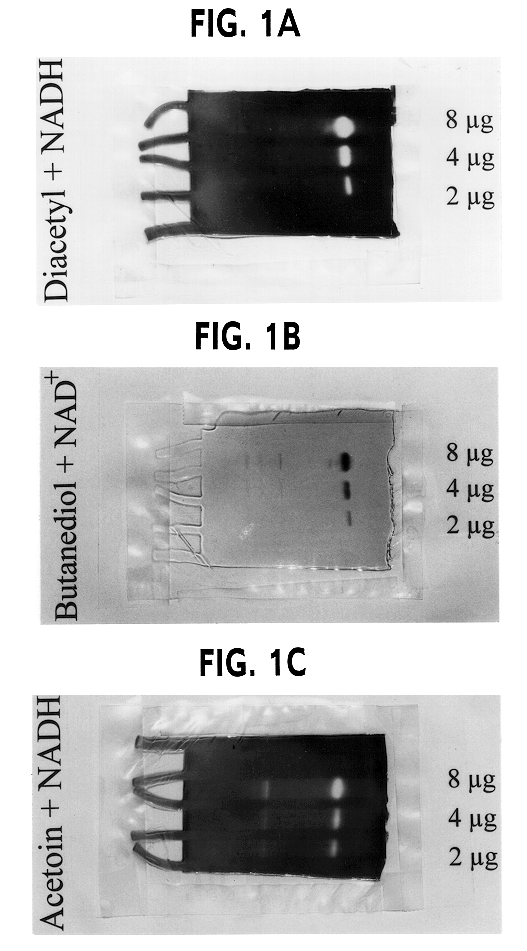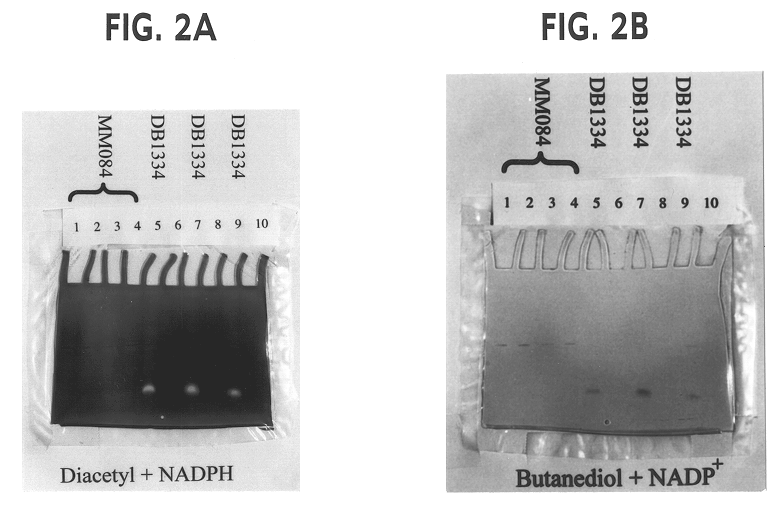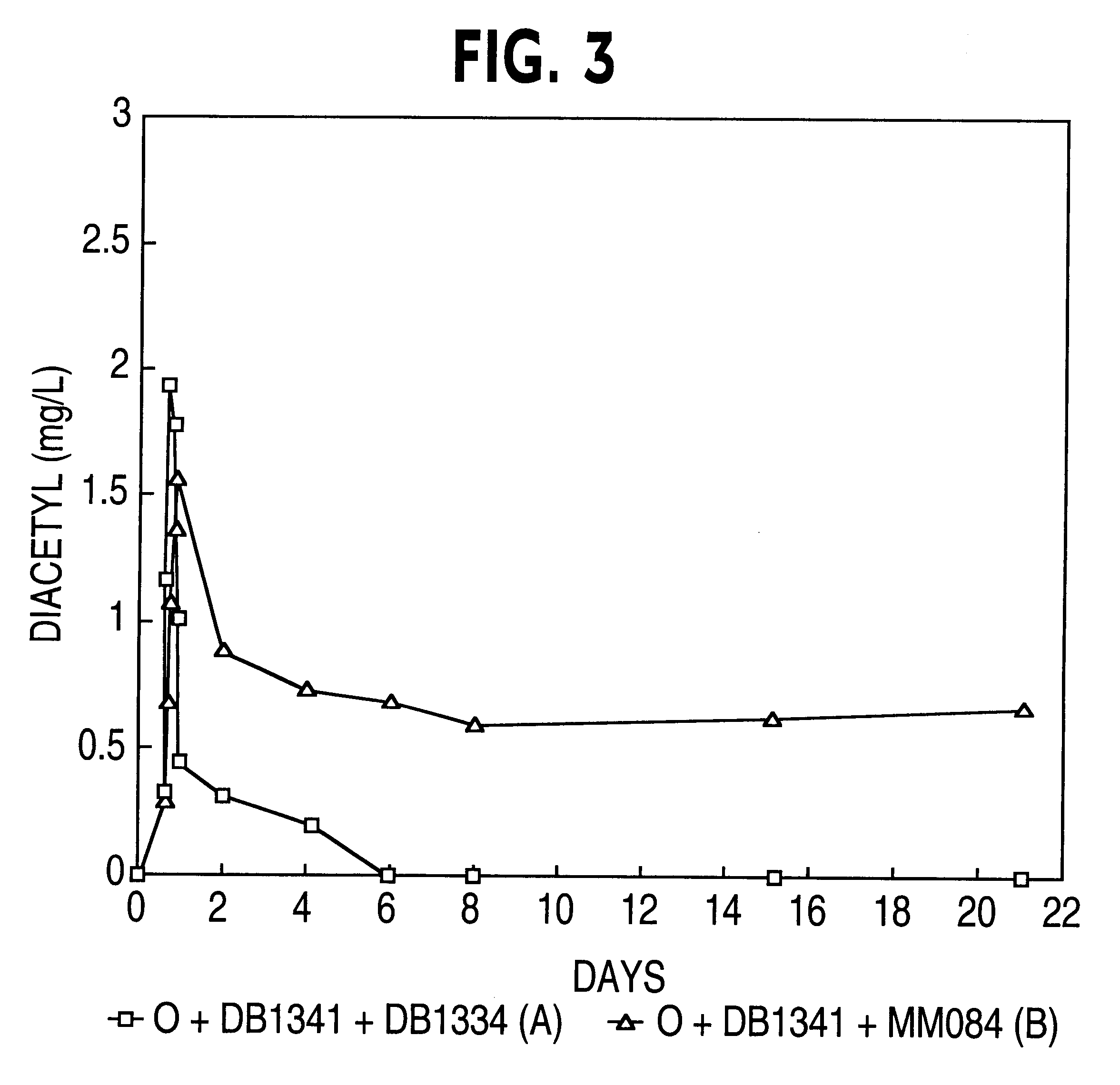Genetically modified lactic acid bacteria having modified diacetyl reductase activities
a technology of diacetyl reductase and lactic acid bacteria, which is applied in the field of genetically modified lactic acid bacteria having modified diacetyl reductase activities, can solve the problems of reducing ph and undesirable presence of ph in other products, such as fruit juice, beers and wines
- Summary
- Abstract
- Description
- Claims
- Application Information
AI Technical Summary
Benefits of technology
Problems solved by technology
Method used
Image
Examples
example 2
Demonstration of both NADH- and NADPH-dependent Diacetyl Reductase Activities in Leuconostoc pseudomesenteroides and Construction of Mutant Strains Totally Blocked in Diacetyl Reductase Activities
2.1. Summary of Experiments
example 1
In Example 1 the construction of a diacetyl reductase mutant with no essentially activity for diacetyl+NADH is described. However, the mutant possessed diacetyl reductase activities as the wild-type strain when using NADPH as cofactor. This strain was able to degrade diacetyl at the same rate as the wild-type strain. The NADH-dependent diacetyl reductase mutant was subjected to further mutagenization and screened for mutants incapable of reducing diacetyl both in the presence of NADH and NADPH as cofactors
2.2. Materials and Methods
(ii) Bacterial Strains
Leuconostoc pseudomesenteroides DB1334 (CHCC2114), MW008 (NADH-dependent diacetyl reductase mutant, see Example 1) and MM0084 (NADH-, NADPH-dependent diacetyl reductase mutant, this Example).
(ii) Cultivation Conditions
DB1334, MW008 and MM084 were cultivated on M17 (0.5% glucose) plates, or in liquid medium, at 25.degree. C. under anaerobic conditions.
(iii) Mutagenesis
MW008 was cultivated in 10 ml M17 (0.5% glucose) for three days foll...
example 3
Effect of Diacetyl Reductase Deficient Leuconostoc pseudomesenteroides Strain MM084 on Diacetyl Stability in Fermented Dairy Products Under Storage
3.1. Introduction
As described in Example 2, the diacetyl reductase mutant MM084 is isolated as a double mutant of Leuconostoc pseudomesenteroides strain DB1334 and lacks both NADH and NADPH dependent DR.
When cultivated in milk as a pure culture, MM084 does not reduce diacetyl and acetoin. Due to this characteristic, mutant MM084 is assumed to be a suitable strain for use as a component in mesophilic cultures which results in an improved diacetyl stability in the fermented products. In this Example, the effect of the mutant MM084 on flavour formation and stability in fermented milk was investigated with main focus on the concentration of diacetyl.
3.2. Materials and Methods
(i) Bacterial Strain
The strains used in this example originate from the Chr. Hansen Culture Collection:
Lactococcus lactis subsp. lactis DB1387 (O strain);
Lactococcus lact...
PUM
| Property | Measurement | Unit |
|---|---|---|
| Fraction | aaaaa | aaaaa |
| Fraction | aaaaa | aaaaa |
| Mass | aaaaa | aaaaa |
Abstract
Description
Claims
Application Information
 Login to View More
Login to View More - R&D
- Intellectual Property
- Life Sciences
- Materials
- Tech Scout
- Unparalleled Data Quality
- Higher Quality Content
- 60% Fewer Hallucinations
Browse by: Latest US Patents, China's latest patents, Technical Efficacy Thesaurus, Application Domain, Technology Topic, Popular Technical Reports.
© 2025 PatSnap. All rights reserved.Legal|Privacy policy|Modern Slavery Act Transparency Statement|Sitemap|About US| Contact US: help@patsnap.com



